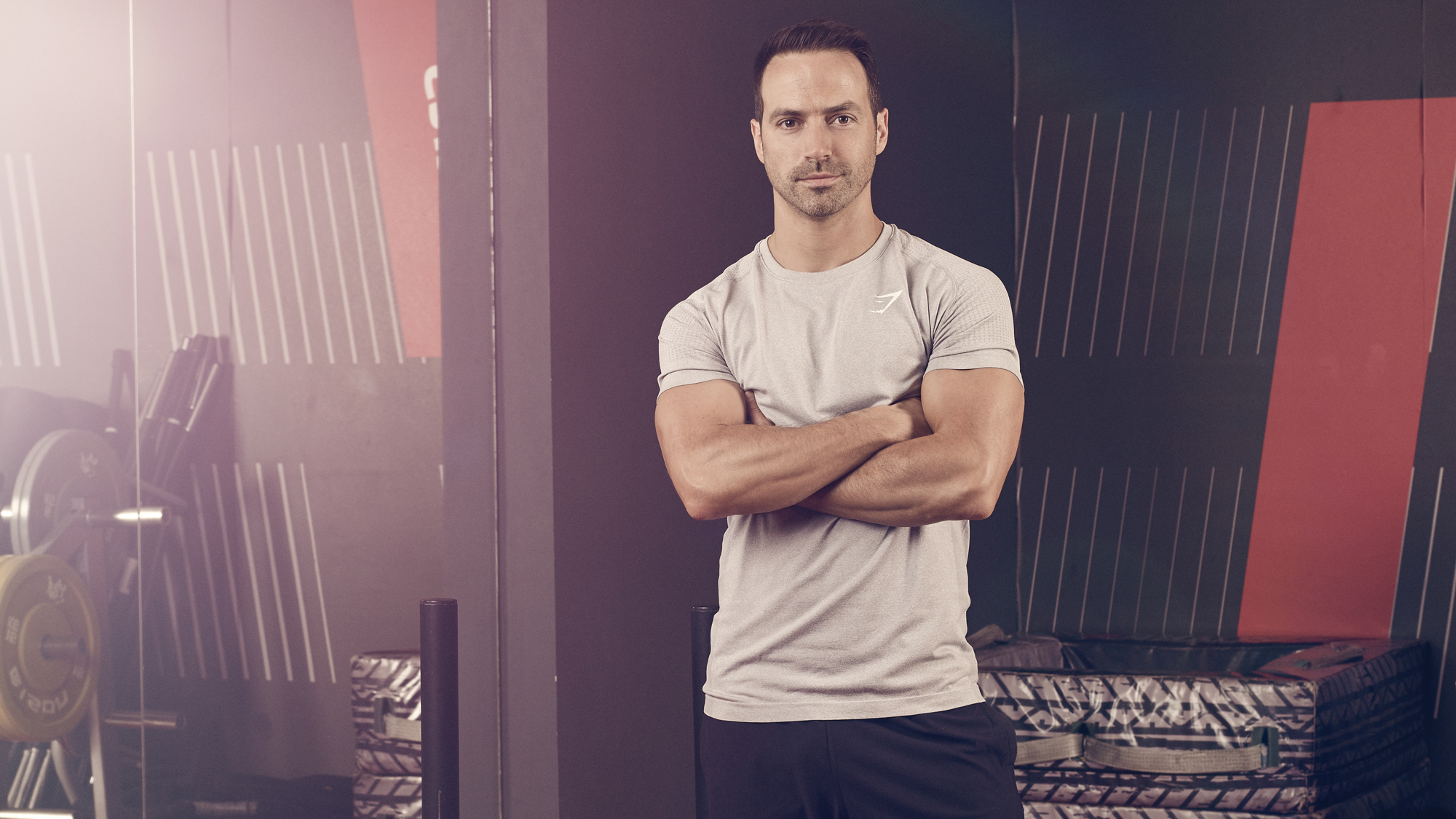7 Essential Barbell Exercises To Get Stronger
The secret behind getting strong? Pick the right barbell exercises. Follow this guide to build strength fast
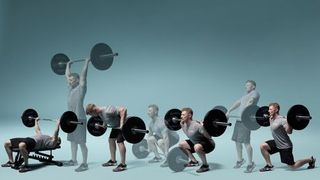
While everyone’s training routine is a little different, as are their overall fitness goals, there are some things that appeal to all gym-goers. Effective exercises that make you stronger without having to spend hours in the weights room definitely fall into that category.
We’ve assembled seven such exercises below, and when you scan down to read them you’ll see that they’re all barbell exercises. That’s because the barbell is your best friend when it comes to building strength and size in an efficient manner.
The Benefits Of Barbell Exercises
“When you’re strength training, the best tool you can use is the barbell,” says personal trainer Tom Wright. “Nothing else comes close. Lifting for strength requires multi-joint exercises known as compound lifts, which create tension through different muscles and movement patterns, and they stimulate thousands of nerves all of which are a part of getting stronger.
“No other equipment allows such dramatic improvements in overall strength. Start out using a weight you’re comfortable with, increase the load every week and watch your numbers fly up.”
How And When To Use These Exercises In Your Training
You’ll find our seven top barbell exercises below, but you shouldn’t just hit the gym and knock them all out in order as your punishing new workout routine. It’s important to be smart when incorporating heavy barbell lifts into your training to get the maximum benefits and avoid any risk of injury.
“Because these movements recruit a large number of motor units and provide a big stimulus to the central nervous system, I always put them at the start of training sessions,” says Wright. “Generally you pick two of these exercises as your main lifts, such as squat and deadlift for a lower-body session, or bench press and barbell row for the upper body.”
Of course, we don’t mean you should dive straight in at the deep end with your main lifts. Prepare with this gym warm-up first, then do warm-up sets with an empty barbell, progressively adding weight until you’re at your target weight.
Get the Coach Newsletter
Sign up for workout ideas, training advice, reviews of the latest gear and more.
You can also do a set of moves that hit both the upper and lower body in one session.
“This upper/lower style of training can allow you to get more work done in a shorter amount of time because less recovery time is required when you move between body parts,” says Wright. “Another benefit of this method is increased heart rate as the body pumps blood from one area to another, leading to a higher metabolic rate and increased fat burning.”
Here are the seven barbell exercises you need to know about. Click the link in the bulleted list below to jump to that entry.
The Magnificent 7
Use these links to jump the relevant section of this article.
Bench Press

Essential form: Start with your arms locked and the bar above your chest. Press your shoulders into the bench, plant your feet on the floor and squeeze your glutes. Bend your elbows to lower the weight to your chest, then press back up to the start.
Targets: chest, triceps, front shoulders
If you want to build an impressive upper torso then the bench press is king. “A trifecta of pecs, shoulders and triceps makes this compound pushing movement, along with the deadlift and squat, one of the true tests of strength,” says Wright. “This lift also allows you to load up your triceps with more weight than you could lift on assistance exercises such as dips or press-downs.”
Beyond The Chest
The bench is all about your pecs, right? Wrong. “It requires a lot of pushing power, which means that to join the big boys you’ll need a strong upper back too,” says Wright. “Make sure you control your shoulder blades by keeping them fixed on the bench. This tension will keep you in a stable position on your big lifts and stop you moving around. If you’ve ever seen a powerlifter bench they use this to the extreme, lifting their hips clear off the bench and planting their feet, squeezing their muscles tight from their shoulder blades all the way down their back to the floor.”
Be Single-Minded
If you have strong chest muscles but you’re weak in your shoulder stabilisers, you’ll struggle to lift a serious amount of weight on the bench press. To maintain good shoulder joint health and give yourself the best chance of going big, try this assistance exercise. “A great variation for bench press is the single-arm dumbbell press,’ says Wright. “It requires immense shoulder control as well as a strong core to stay balanced. If you think you might have one side stronger than the other then throw this in once a week and your imbalances will soon become a thing of the past.”
Use Your Body
Being able to control your own bodyweight is often a great way of laying the kind of foundations that will allow you to lift some significant weight when you use external resistance, such as a barbell. “The best assistance exercise for bench press would be dips or a close-grip pressing exercise that works the same muscles in a slightly different movement pattern,” says Wright. “Once you can perform ten controlled bodyweight reps start to add some weight either with a belt or by holding a dumbbell between your feet.”
Discover more with our everything guide to the bench press.
Bent-Over Row

Essential form: Hold the bar with a shoulder-width grip, bending your knees slightly, then bend at the hips until your torso is at a roughly 45° angle to the floor. Pull the bar up to touch your stomach and then lower under control. If you’re moving your upper body to shift the bar, the weight’s too heavy.
Targets: biceps, lats, core
You should be spending the same amount of time training your back as you do your chest, and the key move is the bent-over row. “The barbell row is a great way to develop a strong upper body and add size to your back, and it’s the only exercise to work all the different muscles that make up the rear of your torso,” says Wright. “The move requires not only a strong pull but also the ability to keep yourself fixed in the bent-over position, which takes strong spinal erectors – technically part of your core muscles."
Keep Your Shoulder Blades Engaged
If you want to lift a decent weight and activate the target muscle groups effectively, your start position is incredibly important. “You should always initiate the row by ‘setting’ your shoulder blades,’ says Wright. “To do this, pull them back and down by squeezing the muscles between them and expanding your chest, then let your elbows follow through to your sides. Think of your hands as hooks - they are simply there to hold the weight, not to pull it. You can even try a thumbless grip. This will engage your lats and help you get a better contraction in the muscle.”
Use The Right Muscles
It may not seem like a complicated move but there are some common mistakes that you can avoid. “The first is not pulling with the back and instead using too much biceps,” says Wright. “You must first activate the muscle you want to use and then move through the full range of movement. Secondly, loading up the bar with too much weight will cause you to lose form, and decrease the range of movement. Performing reps too quickly can also hinder progress. Remember, time under tension should be approximately 40 seconds for muscle growth, so control the weight and keep the tension on the muscles.”
Underhand Tactic
Once you know how to do the move perfectly, you can begin to play around with variations to get a different training effect. “If you’re looking to build your lats – your big back muscles – in particular try using an underhand grip with a narrow hand placement because this will target your lats and lower back,” says Wright. “As well as greater lat recruitment, it also uses more of the biceps too. Rows have been shown to be more effective for building your lats than even lat pull-downs.”
Add In Dumbbell Rows
Want to get even better at rows? Then do this assistance move. “My favourite assistance exercise for the barbell row is the braced dumbbell row,” says Wright. “Place one hand on a bench and take a wide stance with your feet, bracing through your trunk. Let the dumbbell hang down, then pull back and up so it travels along a curved path to the bottom of your ribcage. Rowing with one arm allows greater range of movement and is also great for developing your obliques and core.”
Get more pointers with our bent-over row guide.
Deadlift
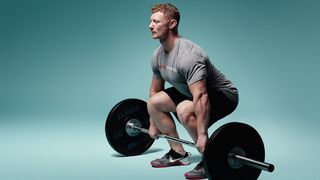
Essential form: Standing with your feet shoulder-width apart, grasp the bar with your hands just outside your legs. Lift the bar by driving your hips forwards, keeping a flat back. Lower the bar under control – though once you get up to really heavy weights, it’s OK to drop your final rep.
Targets: whole body
If you’re looking for raw strength then the deadlift is the move for you. “It’s a posterior chain builder, working the muscles on the rear of your body to pull the bar from floor to hip,” says Wright. “The deadlift will allow you to move more weight than any other barbell exercise, so use it to develop your overall strength and power.”
Brains And Brawn
Deadlifting is all about brute strength executed with sound technique. “Although pulling weight off the floor may sound simple enough, there are actually quite a lot of things you can get wrong,” says Wright. “Poor technique lets down the majority of deadlifters in your average gym, and can cause serious injury. When setting up for your lift you want to remember to pull your shoulders back and your chest out, locking down your shoulder blades. This creates tension in your back that will help prevent you from rounding the lower back or having your hips come up too early. Your goal is to drive the hips towards the front wall, so lean back into the lift and squeeze your glutes hard while pressing through your heels in to the floor.”
Hard And Fast
Even if you’re a beginner you’ll quickly progress to having at least 100kg on the bar. And when it start getting serious, you don’t want to lift with suspect technique. “If you find you’re struggling to perform this lift with good technique, then start with some rack pulls – which means setting the bar up in a rack around 30cm off the floor,” says Wright. “You’ll develop the strength in a shorter range of movement.” And if you’re finding that you’re having to grind out every rep, you may want to work on your speed of lift.
“To help build your deadlift speed, work on heavy kettlebell swings. By firing your hips forwards against the weight of the kettlebell you’ll build stronger glutes and hip drive, supercharging your deadlift power.”
Continue mastering the king of lifts with our deadlift guide.
Back Squat
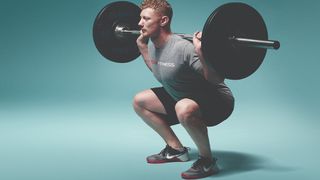
Essential form: Take the bar out of the rack with it resting on your rear shoulder muscles. Take two big steps back and stand with your feet roughly shoulder-width apart, toes pointing slightly out. Keep your spine in alignment by looking at a spot on the floor about two metres in front of you, then “sit” back and down as if you’re aiming for a chair. Descend until your hip crease is below your knee. Keep your weight on your heels as you drive back up.
Targets: quads, glutes and hamstrings
Walk in to any serious gym and the one question you will always be asked is, “What do you squat?” Like it or not, your strength will generally always be judged on the squat numbers you can put up. “People new to lifting fixate on bench press but the truly strong guys will go straight below the belt,” says Wright. “The reason the squat is a great measure of strength is because it works both lower and upper body at the same time while connecting the two with a strong core.”
No Half Measures
If you’ve spent any time in gyms you’ll probably have seen people loading up the bar and doing half reps in the squat rack. They might be pleased with themselves but they’re wasting their time. “A proper squat requires the hips to come down at least until they’re level with the knees,” says Wright. “You’ll hear the phrase ‘past parallel’ and this refers to the thighs being in line with the floor. Fail to go deep enough and your muscles won’t get the stimulus they need to get bigger and stronger. Work on your mobility for five to ten minutes before any squat session –this will give you extra depth, making a huge difference to your results as well as helping you to avoid injury.”
Whole Body Benefit
While the squat is primarily a legs exercise, the upper body is also involved and becomes increasingly important the heavier the weight you’re trying to lift. “An easy way to improve your squat is to make sure your back is tight and your chest is high,” says Wright. “Grip the bar and pull it down on to your shoulders. Raise your chest and push your elbows forwards. This will give you a stronger platform for the bar to sit on and means less work for your core and legs to do. You’ll be surprised at the difference this makes.”
Add In Bulgarian Split Squats
An imbalance of strength between your left and right sides is likely to lead to poor movement patterns and, ultimately, injury. Doing an exercise that develops strength unilaterally will help guard against that. “Once you have done your squats, move on to some Bulgarian split squats,” says Wright. “Holding a pair of dumbbells, take a split stance with one foot ahead of you and the other behind, and place your back foot onto a bench.
Perform a split squat by lowering your back knee while keeping your front shin vertical. This will develop your leg strength as well as balance and is an excellent assistance move for the back squat.”
Continue your development with our guide to mastering the back squat.
Overhead Press
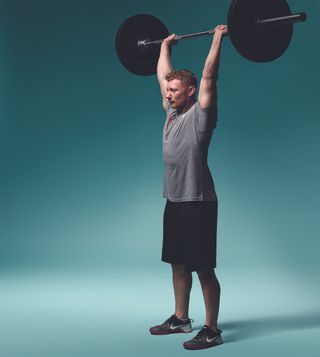
Essential form: With your feet shoulder-width apart, position a bar on your upper chest, gripping it with hands just wider than shoulder-width apart. Brace your abs, glutes and quads as you press the bar straight upwards. Pause at the top, then lower. You may find you lift more weight by wrapping your thumbs around the same side as your fingers, to keep your forearms in a more favourable position.
Targets: shoulders, triceps
Hoisting a heavy weight above your head is a true old-school test of strength. “The overhead press requires strength and balance as well as shoulder mobility and stability,” says Wright. “This exercise will create bigger delts as well as a strong back – plus greater overhead strength, which will transfer over to the bench press.”
The Only Way Is Up
Pressing the weight directly overhead, rather than slightly in front of you, is key to going heavy. “When performing the overhead press remember that the weight should be over your centre of gravity, passing through your head, the top of your spine, your hips and your ankles,” says Wright. “Keep these in line by squeezing your abs and glutes and pushing your head through once the bar has passed your nose. You’ll also add about 10% to your lift by simply keeping your core tight – so squeeze those glutes!”
Protect Your Neck
A good overhead press relies on good mobility and that means being able to retract your shoulder blades and push your elbows through so that they are directly under the bar. To help develop that ability, try starting the move with the weight behind your neck. “Once you have mastered the military press (with feet together) you can try the behind-neck press,” says Wright. “The same rules apply, only you begin with the bar on your back. This variation will work your rear delts and back more, but you’ll need to drop the weight by around 30% and take a slightly wider grip.”
Add In The Landmine Press
Your shoulder joints are delicate because they are freely moveable and involve a group of small stabilising muscles called the rotator cuff. The upshot is that it’s easy for something to go wrong, particularly when you’re tired. “To improve shoulder health and stability, perform the landmine press after your overhead work,” says Wright. “Wedge one end of a bar into the corner of the room and perform a single arm shoulder press. Remember to stay strict and allow your shoulder blades to move while keeping your abs tight.”
Browse variations, assistance lifts and more with our guide to the overhead press.
Lunge
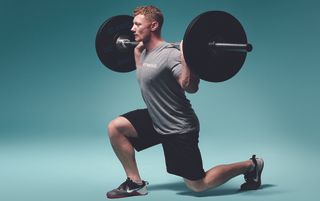
Essential form: Stand with a barbell resting on the back of your shoulders. Retract your shoulder blades and keep your back upright and core braced throughout. Take a big step forwards and lower your body until both knees are bent at 90˚ before pushing back off your front foot to return to the start position.
Targets: quads, glutes and hamstrings
The barbell lunge is an excellent lower-body builder because it allows you to apply heavy loads on to a single leg in a dynamic movement. “This exercise has many variations and can be used to target many different muscles of the lower body,” says Wright. “It is one of the most under-used movements for developing athletic ability.”
Tight Trunk
Although the lunge is primarily a lower-body move, the fact the weight is on your back puts the force through your trunk. “The tighter you can keep your trunk, the more stable you will feel and the more powerful you will become,” says Wright. “Try to make yourself as tall as you can, pulling your abs in and shoulders back, then lunge forwards. Short lunges will load the quads, whereas a longer stride will place emphasis on the hamstrings and glutes. If your ankle is flexed and your knee’s forwards you are loading the front of the leg, if not then you’re working your posterior chain.”
Reverse To Progress
If the standard lunge is rare then the reverse lunge is virtually an endangered species. Doing the move in reverse has a host of benefits, including improving your proprioception (your body’s ability to sense its own position, develop balance and co-ordinate movements). “If you struggle with lunges it may be to do with tight hip flexors or ankles, so the reverse lunge is a great progression,” says Wright. “The same principles apply but it allows you to drop your hips backwards and step back up, which will help you to improve up to the full walking lunge.”
Take A Long Lunge
Doing any form of lunge will help to improve your athletic ability because it’s a heavy compound exercise that involves an unstable unilateral movement. There are, however, ways you can perform it so that you get an elite-level benefit. “To develop power and speed I perform longer lunges and drive up through my front heel, engaging my glutes,” Wright says. “Without stopping at the top I allow my hips to continue forward in a natural arc into the next lunge. This is much more like a natural gait when running, and it helps keep tension in the core and build strength and power.”
Power Clean

Essential form: Start with the barbell on the floor, holding it with a shoulder-width grip. Drive through your heels to lift it off the floor, then explode up as it passes your knees, using the momentum to help pull it up to chest height and “catching” it on your chest. Pause for a second, then drop or lower the barbell for the next rep.
Targets: whole body
This is the one move in the series dedicated to increasing power and speed. “The power clean has been used by athletes for years to improve their performance on the field,” says Wright. “Building power requires improving speed against resistance, and a power clean allows you to develop full-body power by combining a deadlift and a hang clean.”
Warm Up Properly
You should place the power clean at the start of your session – but that doesn’t mean you walk straight out of the changing room, stick a couple of 20kg plates on the end of the bar and get lifting. “Make sure you are warmed up properly and your shoulders and lats are mobile to allow you to get under the bar quickly,” says Wright. “Being able to get in the front rack position quickly is key. The speed of the middle section is what will make or break your lift, so think about fast execution of the hip drive or ‘second pull’ and explode upwards, keeping the bar close to your body.”
Hang Clean
If you usually train while wearing tracksuit bottoms and aren’t too bothered about growing tree-trunk legs, you can do the hang clean variation of the move which involves starting the move while holding the bar. The other benefit of that version is that it improves your grip strength, which can, in turn, have a positive effect on your power and squat clean ability. “The hang clean, where the bar originates from the hips rather than the floor, is ideal if you want to focus solely on the upper body,” says Wright. “It’s also a good progression up to a power clean.”
Power Through
Power cleans will place a huge energy demand on your body but that’s no excuse to slack off once you’ve got to the end of your last set. “The two movements I like to use in the same session as power cleans are box jumps and thrusters,” says Wright. “Box jumps will improve your speed and power, while the thruster is like a continuum of the movement because it involves going from a front squat to a shoulder press. Thrusters in particular help to connect all the pieces of the puzzle by strengthening the connection between lower and upper body.
Use our guide to the power clean to master the movement.
Photography: Glen Burrows; Model: Tom Wright
Jon Lipsey worked for Men’s Fitness UK, which predated, and then shared a website with, Coach. Jon was deputy editor and editor from 2007 to 2013. He returned as editor-in-chief from 2016 to 2019. He also co-founded IronLife Media and the New Body Plan.
